PALLASITES: A Rare View
The pallasites displayed on this page are seldom represented in private collections, and some not at all. All photos are courtesy of Dr. J. Piatek.
I’d like to express my appreciation to Dr. Piatek for sharing his rare
pallasiteOne of two main classes of stony-iron meteorite, the other being mesosiderites. Pallasites are igneous in nature and characterized by crystals of olivine, sometimes peridot (green gem quality clear olivine crystals), embedded in a matrix of Fe-Ni metal. The type specimen, weighing 680 kg, was found in the mountains near Click on Term to Read More collection on MeteoriteStudies.com.
Omolon—PMG
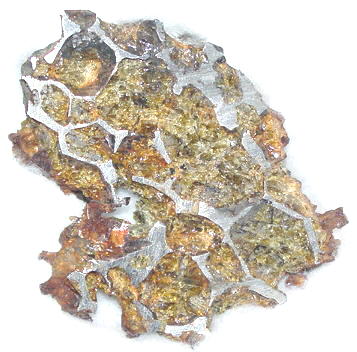
A pallasite was seen to
fallMeteorite seen to fall. Such meteorites are usually collected soon after falling and are not affected by terrestrial weathering (Weathering = 0). Beginning in 2014 (date needs confirmation), the NomComm adopted the use of the terms "probable fall" and "confirmed fall" to provide better insight into the meteorite's history. If Click on Term to Read More on May 16, 1981, and a single 253.5 kg mass was located a short time thereafter along the Omolon River in the Magadan region of the USSR. This mass was finally recovered a few years later. Omolon is one of only three verified pallasite falls, sharing this distinction with Marjalahti and Zaisho, and has a composition which places it in the main-group. The photo above shows a stunning 67.05 g slice of this rare fall, acquired from the Russian Academy of Sciences.
Giroux—PMG
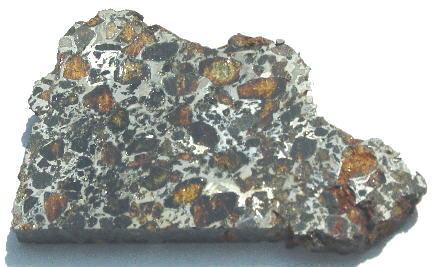
A single 4.275 kg pallasite was found by Francis Langill in Manitoba, Canada during the winter of 1954. Giroux has a composition which places it in the main-group. In the photo above is a 168 g partial slice, acquired in trade from the United States National Museum, Smithsonian Institution.
Phillips County—PMG-as

A single 1.4 kg pallasite was found in Colorado, USA in 1935. Phillips County is unusually troilite-rich and has
olivineGroup of silicate minerals, (Mg,Fe)2SiO4, with the compositional endpoints of forsterite (Mg2SiO4) and fayalite (Fe2SiO4). Olivine is commonly found in all chondrites within both the matrix and chondrules, achondrites including most primitive achondrites and some evolved achondrites, in pallasites as large yellow-green crystals (brown when terrestrialized), in the silicate portion Click on Term to Read More with an anomalously high
fayalitePure* iron end-member (Fe2SiO4) of the olivine solid solution series and an important mineral in meteorites. When iron (Fe) is completely substituted by magnesium, it yields the the pure Mg-olivine end-member, forsterite (Mg2SiO4). The various Fe and Mg substitutions between these two end-members are described based on their forsteritic (Fo) Click on Term to Read More content, leading to its designation as an anomalous member of the main-group. Olivines occur as a mixture of rounded crystals and small, sharp fragments. The photo above shows a 94.4 g partial slice, acquired from the Jim Schwade Collection, previously obtained from David New following acquisition from Arizona State University, Center for
MeteoriteWork in progress. A solid natural object reaching a planet’s surface from interplanetary space. Solid portion of a meteoroid that survives its fall to Earth, or some other body. Meteorites are classified as stony meteorites, iron meteorites, and stony-iron meteorites. These groups are further divided according to their mineralogy and Click on Term to Read More Studies.
Milton—ungrouped
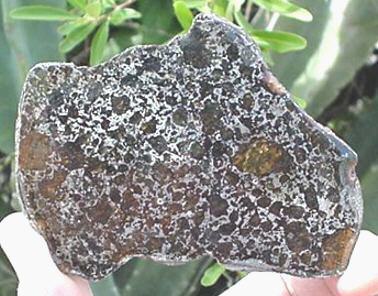
A single 2,038 g pallasite was found in Missouri, USA in October 2000. Olivine comprises ~73 vol% in Milton, which, along with the FeNi-metal, is chemically different from other pallasites. In addition, Milton also has unique O-isotope ratios, suggesting an origin from a previously unsampled asteroid. The photo above shows a 75 g slice from the 1,340 g
main massLargest fragment of a meteorite, typically at the time of recovery. Meteorites are commonly cut, sliced or sometimes broken thus reducing the size of the main mass and the resulting largest specimen is called the "largest known mass". Click on Term to Read More purchased from the finder.
read more >>
Eagle Station—PES
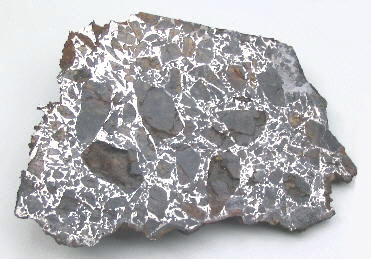
A single 36.3 kg pallasite was found in Kentucky, USA in 1880. Eagle Station is the type specimen for a unique pallasite group consisting of Eagle Station, Cold Bay (see below), Itzawisis, Karavannoe, and Oued Bourdim 001. These pallasites have different
metalElement that readily forms cations and has metallic bonds; sometimes said to be similar to a cation in a cloud of electrons. The metals are one of the three groups of elements as distinguished by their ionization and bonding properties, along with the metalloids and nonmetals. A diagonal line drawn Click on Term to Read More and olivine compositions than those of the main-group clan. Shown in the photo above is a 185 g end section, acquired from the Jim Schwade Collection, previously part of the Vienna Museum Collection.
read more >>
Cold Bay—PES
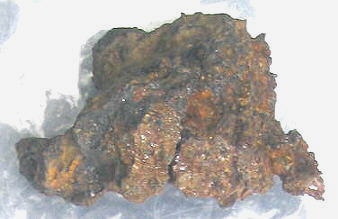
Many corroded fragments of this pallasite, having a combined weight of 320 g, were found in Alaska, USA in June 1921. This ‘silicated rust’ has experienced selective corrosion of
kamaciteMore common than taenite, both taenite and kamacite are Ni-Fe alloys found in iron meteorites. Kamacite, α-(Fe,Ni), contains 4-7.5 wt% Ni, and forms large body-centered cubic crystals that appear like broad bands or beam-like structures on the etched surface of a meteorite; its name is derived from the Greek word Click on Term to Read More,
i.e., the fine kamacite that was originally a constituent of
plessiteA fine-grained intergrowth of kamacite and taenite that fills in the wedges between wide kamacite and taenite bands in octahedrites. The name derives from the Greek word for "filling." Click on Term to Read More has been
oxidizedOxidation and reduction together are called redox (reduction and oxidation) and generally characterized by the transfer of electrons between chemical species, like molecules, atoms or ions, where one species undergoes oxidation, a loss of electrons, while another species undergoes reduction, a gain of electrons. This transfer of electrons between reactants Click on Term to Read More. Cold Bay is one of the five representatives of the Eagle Station group. Although they all share similar compositions, Cold Bay is derived from a more evolved
magmaMolten silicate (rock) beneath the surface of a planetary body or moon. When it reaches the surface, magma is called lava. Click on Term to Read More than that which formed Eagle Station. The photo above shows a 20 g fragment, acquired in trade from the United States National Museum, Smithsonian Institution.
Itzawisis—PES
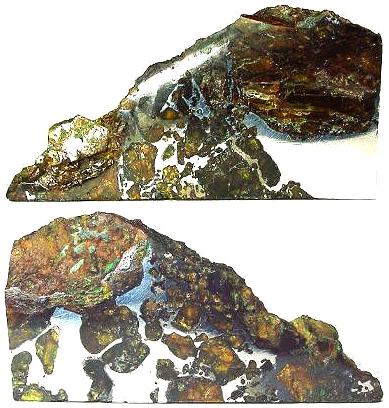
A fresh meteorite weighing 350 g was found in Namibia in 1946, but the main mass was discovered to be missing some years ago. Itzawisis is one of five members composing the anomalous Eagle Station group. Angular silicates constitute ~75 vol%, while the remainder consists of FeNi-metal with accessory
troiliteBrass colored non-magnetic mineral of iron sulfide, FeS, found in a variety of meteorites. Click on Term to Read More,
chromiteBrownish-black oxide of chromium and iron (Cr-Fe oxide), Cr2FeO4, found in many meteorite groups. Click on Term to Read More, and whitlockite. These pallasites have the highest Fa value and the highest Ni content of all other pallasites, and their chromium and
oxygenElement that makes up 20.95 vol. % of the Earth's atmosphere at ground level, 89 wt. % of seawater and 46.6 wt. % (94 vol. %) of Earth's crust. It appears to be the third most abundant element in the universe (after H and He), but has an abundance only Click on Term to Read More isotopeOne of two or more atoms with the same atomic number (Z), but different mass (A). For example, hydrogen has three isotopes: 1H, 2H (deuterium), and 3H (tritium). Different isotopes of a given element have different numbers of neutrons in the nucleus. Click on Term to Read More systematics suggest that a genetic relationship (
i.e., same
parent bodyThe body from which a meteorite or meteoroid was derived prior to its ejection. Some parent bodies were destroyed early in the formation of our Solar System, while others like the asteroid 4-Vesta and Mars are still observable today. Click on Term to Read More) exists between the Eagle Station group and the CV carbonaceous
chondritesChondrites are the most common meteorites accounting for ~84% of falls. Chondrites are comprised mostly of Fe- and Mg-bearing silicate minerals (found in both chondrules and fine grained matrix), reduced Fe/Ni metal (found in various states like large blebs, small grains and/or even chondrule rims), and various refractory inclusions (such Click on Term to Read More. The photo above shows both sides of a 37 g partial slice of Itzawisis, acquired from a major institution.
Newport—PMG
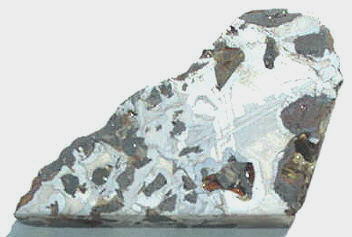
A single 5,600 g pallasite was found in Arkansas, USA in 1923, and described by Harvey Nininger. Newport contains an unusually low olivine proportion of 37 vol%. It contains minor daubreelite and
pentlanditeFe-Ni sulfide, (Fe,Ni)9S8, that is often associated with troilite, and found in the matrix and chondrules of CO, CV, CK and CR chondrites. The color is yellow-bronze with light bronze-brown streak and metallic luster. It typically forms during cooling of magmatic sulfide melts during the evolution of parent silicate melt. The Click on Term to Read More associated with troilite, mackinawite, and native copper, reflecting low temperature reactions. In the photo above is a 122 g partial slice, acquired from the Jim Schwade Collection, previously obtained from David New following acquisition from Arizona State University, Center for Meteorite Studies.
Dora—PMG
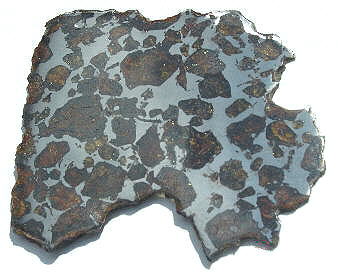
A single, 7.6 kg,
fusionProcess in which two lighter atomic nuclei combine to form a heavier atomic nucleus. Very high temperatures are normally required in order for atomic nuclei to collide with sufficient energy to overcome the Coulomb barrier (their mutual electrostatic repulsions). Fusion that occurs under high-temperature conditions is called thermonuclear fusion. Fusion Click on Term to Read More crusted pallasite was unearthed by a farmer plowing in New Mexico, USA around 1955. It was left beside a fence row for about 10 years until it was recognized as a meteorite in 1967. The angular olivines in Dora are indicative of early shock fracturing followed by a period of annealing. The photo shown above is a 157 g partial slice, acquired from the Robert Haag Collection, previously obtained from the Institute of
MeteoriticsScience involved in the study of meteorites and related materials. Meteoritics are closely connected to cosmochemistry, mineralogy and geochemistry. A scientist that specializes in meteoritics is called a meteoriticist. Click on Term to Read More, University of New Mexico.
Finmarken—PMG
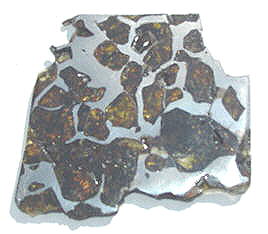
A single 77.5 kg pallasite was found in Finmark, Norway in 1902. This pallasite is unusual for its Ir enrichment and moderate As and
AuThe astronomical unit for length is described as the "mean" distance (average of aphelion and perihelion distances) between the Earth and the Sun. Though most references state the value for 1 AU to be approximately 150 million kilometers, the currently accepted precise value for the AU is 149,597,870.66 km. The Click on Term to Read More enrichment in metal. It also has the highest measured olivine content in a pallasite, with at least 78 vol%. The photo of Finmarken shown above is a 77 g partial slice, acquired from the Robert Haag Collection.
Krasnojarsk—PMG-am
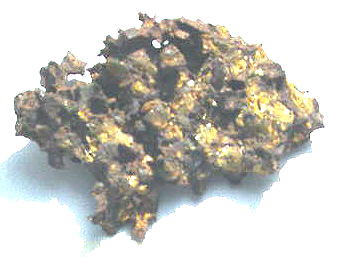
A pallasite weighing 700 kg was found by Johan Mettich on Mount Emir in Siberia, near Krasnoyarsk, in 1749. The mass was later described by the German naturalist Peter Simon Pallas, for whom the meteorite group would later be named. In 1804, in an effort to prevent rust, William Thomson applied nitric acid to this meteorite and discovered the ‘Widmanstätten structure’. Krasnojarsk has the highest content of Co, As, and Sb, and the lowest Ni and Cu, leading to its designation as an anomalous member of the main-group. The photo above shows an 86 g individual, within which are numerous voids that attest to extensive terrestrial weathering. It was acquired from the Jim Schwade Collection, previously obtained from the Bartoschewitz Meteorite Laboratory. Click
here to see a 23 g historical Krasnojarsk specimen, acquired in trade from the United States National Museum, Smithsonian Institution, previously obtained from the Bosch Collection.
Acomita—PMG
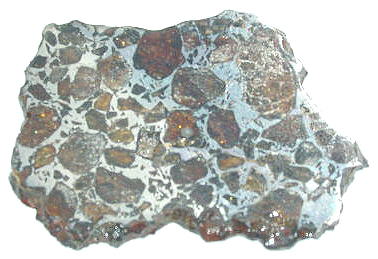
A single 3,956 g pallasite was found beside the road in New Mexico, USA in June 1962, by a man changing a tire. After utilizing the stony-iron to prop up the axle, he tossed it in the back of the truck. Acomita is a typical member of the main-group pallasites, which experienced efficient
fractional crystallizationA crystallization process in which minerals crystallizing from a magma are isolated from contact with the liquid. It is a key process in the formation of igneous rocks during the process of magmatic differentiation. Also known as crystal fractionation. Click on Term to Read More, followed by impact mixing of fractured
mantleMain silicate-rich zone within a planet between the crust and metallic core. The mantle accounts for 82% of Earth's volume and is composed of silicate minerals rich in Mg. The temperature of the mantle can be as high as 3,700 °C. Heat generated in the core causes convection currents in Click on Term to Read More olivine with molten
coreIn the context of planetary formation, the core is the central region of a large differentiated asteroid, planet or moon and made up of denser materials than the surrounding mantle and crust. For example, the cores of the Earth, the terrestrial planets and differentiated asteroids are rich in metallic iron-nickel. Click on Term to Read More iron very early in
Solar SystemThe Sun and set of objects orbiting around it including planets and their moons and rings, asteroids, comets, and meteoroids. history. The photo of Acomita shown above is a 160 g partial slice, acquired from the Robert Haag Collection, previously obtained from Arizona State University, Center for Meteorite Studies.
Mount Dyrring—PMG
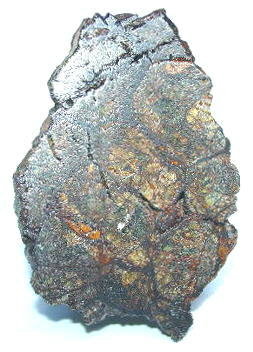
Pallasite fragments having a combined weight of 11.3 kg were found in New South Wales, Australia in 1903. The main mass remains in the Australian Museum in Sydney. The metal in Mount Dyrring has been oxidized during its long terrestrial residence. The photo above shows a 67 g end section, acquired from the Robert Haag Collection. Click
here to see the natural surface on the reverse side of this end section.
CONTINUE TO PALLASITES: A Rare View
[ PART II ]



















